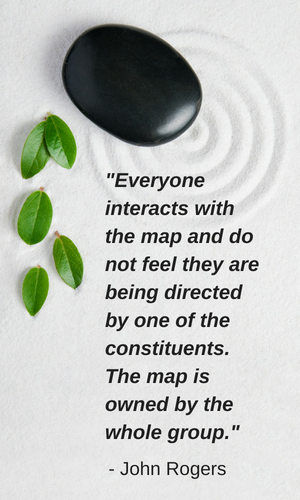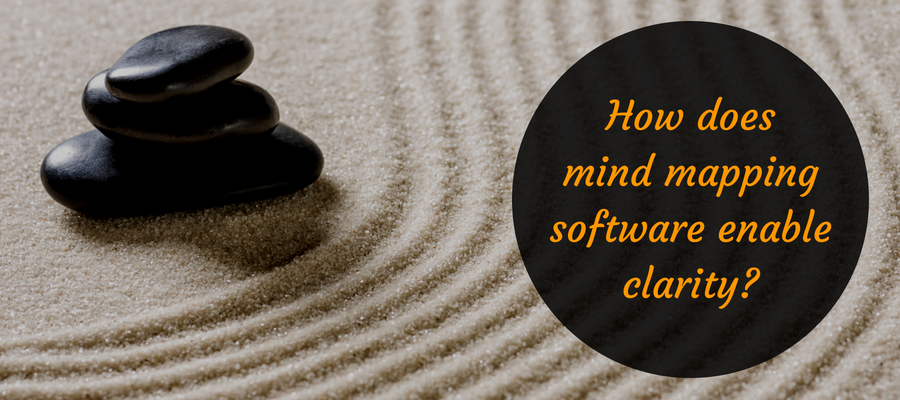During the last decade, my surveys of users of mind mapping software have consistently showed that one of its top business benefits is helping users to reach clarity faster on important business issues. As a sense-making tool, it has no peer. No other type of business software comes close to the functionality and flexibility offered by mind mapping software.
This begs the question:
How, specifically, does mind mapping software help users reach clarity on key business issues?
I put this question to some of the world’s leading mind mappers to get their perspectives on this question. Not surprisingly, their insights exceeded my expectations. Here’s what they had to say:
Jeffrey Ritter
 Jeffrey Ritter does a lot of work with companies, helping teams work their way through complex governance issues. In many cases, he discovers that the team members are all so specialized in their roles that no one has a complete picture of the corporate governance structure. The mind map provides a visible palette upon which they can come to consensus about this important issue.
Jeffrey Ritter does a lot of work with companies, helping teams work their way through complex governance issues. In many cases, he discovers that the team members are all so specialized in their roles that no one has a complete picture of the corporate governance structure. The mind map provides a visible palette upon which they can come to consensus about this important issue.
“Mind mapping works to enable big decisions within business for three reasons:
First, the visual clarity of a mind map enables teams to literally see the full picture. A map shows relationships, priorities, context, and dependencies in a manner not achieved with other tools.
Second, a map functionally puts teams on the same page. They see the same structures, enriched by icons, images, color, shapes, and design, enabling historic obstacles that challenged decision-making when team members each looked at the problems and the solutions differently.
Third, when displayed on a wall in a conference room, maps have a powerful, subliminal impact that is fascinating to observe. Instead of protecting turfs, budgets, and their respective priorities, stakeholders focus on the map and work together to get the map to be correct, complete, and properly designed. In doing so, there is astounding collaboration that often leaves the team members celebrating and asking, “How did we do that so well?”
John Rogers
 John Rogers is the founder of Map4Results, a consultancy where he guides teams and leaders in delivering planned results to their business and clients. As he describes it, “Through the application of innovative visual tools and facilitation, business and project teams are able to come to a shared vision and map out strategies and action plans for the delivery of high-quality results.”
John Rogers is the founder of Map4Results, a consultancy where he guides teams and leaders in delivering planned results to their business and clients. As he describes it, “Through the application of innovative visual tools and facilitation, business and project teams are able to come to a shared vision and map out strategies and action plans for the delivery of high-quality results.”
He recently wrote an article series for this blog on how to plan for and conduct a strategic planning day using mind maps.
“The strength of a team is based on a shared understanding. Capturing the thoughts of the group, echoing them back through a mind map, and ‘talking through’ the map with the group is the fastest way to come to that critical shared understanding. Mind mapping software provides a flexible tool for collecting disparate thoughts and evolving those into a shared understanding and models that can then be actioned by the group.
By using mind mapping software to facilitate group discussions, we have been able to create a shared vision and action plan across organizational boundaries. Everyone interacts with the map and do not feel they are being directed by one of the constituents. The map is owned by the whole group.”
Maneesh Dutt
 Maneesh Dutt is the founder of Inlight Consulting, here he helps organizations develop a culture of innovation and execution excellence. He is the author of the excellent book, Mind Maps for Effective Project Management, and frequently shares keen insights about the dynamics of teams, projects and innovation.
Maneesh Dutt is the founder of Inlight Consulting, here he helps organizations develop a culture of innovation and execution excellence. He is the author of the excellent book, Mind Maps for Effective Project Management, and frequently shares keen insights about the dynamics of teams, projects and innovation.
“To understand how mind mapping enables clarity, we must first look at the the two critical and fundamental functionalities that it provides in an organizational context. First, quickly assimilating large and complex information and, secondly, triggering new ideas. While the first aspect enables better clarity, the second helps to build further on it.
Going another layer deeper, we find that from a user’s perspective, the radiant hierarchy and visual appeal of mind maps helps improve engagement with the subject at hand – which again is critical to enhanced clarity.”
Michael Deutch
 Michael Deutch is vice-president of products for Corel. As the product manager of MindManager is well regarded as an expert source of mind mapping knowledge and practice.
Michael Deutch is vice-president of products for Corel. As the product manager of MindManager is well regarded as an expert source of mind mapping knowledge and practice.
“Traditional productivity apps present information across multiple pages, tabs, and slides making it difficult to recognize important connections, identify issues, draw conclusions, and more.
On the other hand, mind maps and other similar visualizations enable clarity as they present information visually in a centralized place. The non-linear nature of mind maps also makes them conducive for things like brainstorming and planning, as opposed to the linear outline of documents, spreadsheets, and presentations.
Mind maps help to visually clarify relationships between data points, ideas, and information that would have otherwise been missed. As a result, teams can work together to reveal the missing variables that are critical to solving problems, planning projects, and defining strategies.
You can view content at multiple levels of detail. For instance, collapse all your branches in a diagram to get that big picture view, or if you need to get granular, drill in on a specific area.
You can add important visual meta-data in a single topic that might otherwise take paragraphs to describe. A topic can contain icons that indicate priority, importance, progress, and more. Task info highlights critical information to ensure projects are clearly defined. Links, attachments, images, notes, properties also all add additional context and meaning to your diagrams.
Finally, unlike other productivity apps, people can also look at their maps and diagrams with a number of complementary visualizations like a traditional outline, by priority, by time or even a Gantt chart.”
Hans Turhurne
 Hans Turhurne is the founder of the CreaMatics consultancy, where he helps organizations tackle change management using visual thinking tools and techniques.
Hans Turhurne is the founder of the CreaMatics consultancy, where he helps organizations tackle change management using visual thinking tools and techniques.
“Visual thinking with the help of mind mapping software in a group:
- First leads to a common and structured picture,
- At the second place to a common understanding, and
- From there to a group commitment for next steps.
During this process the communication changes from a discussion/debate into a dialogue. This means asking more questions and better listening.”
Nick Duffill
 Nick Duffill is the principal of Harport Consulting. He is a software and product designer, specializing in knowledge and information visualization for business users. When it comes to the applications of mind mapping software for business, he is one of the deepest thinkers I know.
Nick Duffill is the principal of Harport Consulting. He is a software and product designer, specializing in knowledge and information visualization for business users. When it comes to the applications of mind mapping software for business, he is one of the deepest thinkers I know.
His opinions here are an extension of a topic he spoke about for a recent Biggerplate.com webinar. In it, he outlines current understanding of brain science – how the brain understands and processes information – and how some peculiarities of it cause mind mapping to be less than ideal for communicating understanding under certain circumstances. It’s a must-listen!
“I don’t think that is a simple question to answer, because mind maps are great for some kinds of clarity but not all. Complicated things with lots of detail benefit hugely from mind mapping software, but it is relatively poor at communicating the big picture or explaining processes or complex systems that have lots of inter-dependencies.”
What’s your opinion?
What do you think? How, specifically, does mind mapping software enable you to reach clarity quickly? Please share your thoughts and experiences in the comments area below. I look forward to your insights!


Leave a Reply